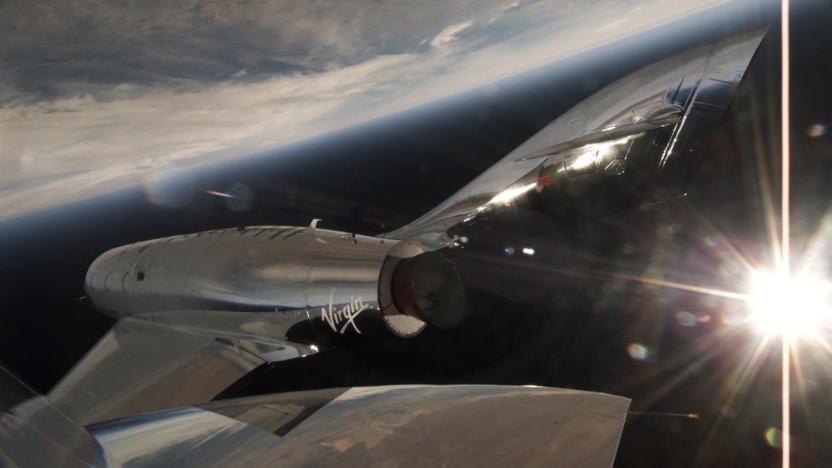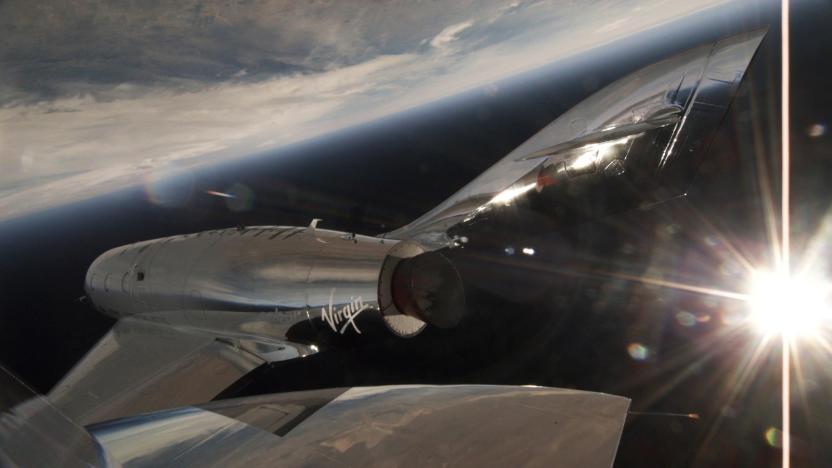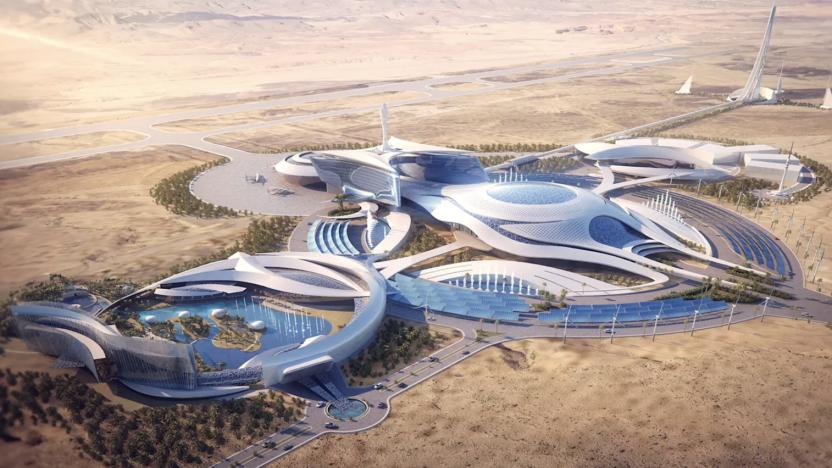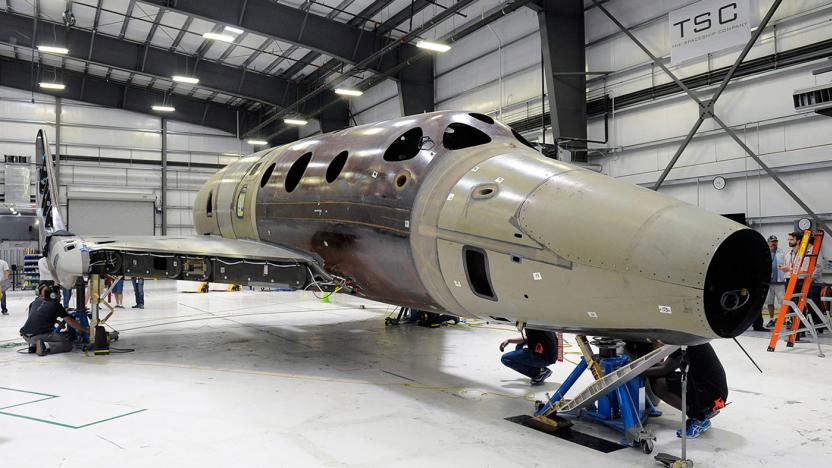SpaceShipTwo
Latest

Virgin Galactic could soon reach space for the first time
Virgin Galactic is leveling up the SpaceShipTwo's test flights and is planning to burn its rocket motor for durations far longer than it has before. The aerospace company's goal? It wants to reach space for the first time. According to Virgin's announcement, the next phase of the program will have its vehicle (officially called VSS Unity) flying higher and faster than before, with much heavier loads to simulate the weight of passengers it's planning to take on suborbital flights.

Watch Virgin Galactic's new SpaceshipTwo take flight
As Virgin Galactic continues its quest to "open" space flight, it completed its first powered test flight since the 2014 crash that killed one of its pilots. Now we have video of the new SpaceShipTwo, VSS Unity, separating from its carry vehicle and using its rocket to reach supersonic speeds. It hit Mach 1.87 during its 30-second rocket burn and then coasted until reaching an altitude of 84,271 ft before preparing for its return.

Virgin Galactic completes first powered test flight since 2014 crash
Today, SpaceShipTwo completed its first powered test since the horrific crash in 2014 that killed one of its pilots. The craft, VSS Unity, took off from Mojave Air and Space Port aboard a plane called CMS Eve, and was piloted by two people. According to Richard Branson, the vehicle went supersonic, up to Mach 1.6. He proclaimed Virgin Galactic "back on track." Update: And now there's video! Check it out here.

Virgin Galactic’s SpaceShipTwo is almost ready for powered tests
Virgin Galactic's SpaceShipTwo might be best known for its horrific crash in 2014, which killed one of its pilots, but the company has slowly been coming back from that setback. Now, the company announced that the reusable craft, called the VSS Unity, has successfully completed its eleventh glide test. The company used used water as a ballast to replicate the conditions of a rocket-powered flight.

Saudi Arabia plans $1 billion investment in Virgin's space tourism
Richard Branson has gained a powerful and extremely wealthy ally that can make his space tourism dreams a reality: Saudi Arabia. The kingdom will invest $1 billion in the Virgin Group's space companies and might even add $480 million more in the future. This investment will fund three companies within the Virgin Group, starting with Virgin Galactic, which is responsible for developing the VSS Unity (also known as SpaceShipTwo) designed to fly paying tourists to suborbital space. Part of the money will also go to The Spaceship Company and Virgin Orbit. The former manufactures Virgin Galactic's spacecraft, while the latter provides launch services for small satellites.

Virgin Galactic conducts a 'dry run' for rocket-powered flights
Virgin Galactic's SpaceShipTwo (official name VSS Unity) has just completed its sixth test glide. The reusable spaceplane still has between two to nine more staged glides to go before the aerospace company moves on to rocket-propelled tests. But this one is special because it serves as a dry run for actual rocket-powered flights. It flew with the configuration a powered flight will have, carrying propulsion components onboard, along with 1,000 pounds of water to simulate the weight of fuel casing.

Virgin Galactic's SpaceShipTwo completes second glide flight
Two years ago, Virgin Galactic's first SpaceShipTwo tragically crashed during a test flight, killing one pilot and severely injuring the other. The company unveiled its successor back in February, the VSS Unity, which has additional safety features to prevent another crash. It completed its first glide test two weeks ago, gathering precious data about how the reusable craft behaves in the air, and just performed a second unpowered flight to round out the year.

Virgin Galactic's new spaceship completes its first glide test
Virgin Galactic just came much closer to resuming its dreams of private spaceflight in the wake of its tragic crash from 2014. The company has successfully conducted the first glide test flight for VSS Unity, better known as the new SpaceShipTwo. The vehicle was only flying free for 10 minutes and never traveled faster than Mach 0.6, but that was enough to get a healthy amount of data illustrating how Unity behaves in real life.

Virgin Galactic gets its spaceship license
Virgin Galactic is one step closer to making us all space tourists: it just received its operator license from the US Federal Aviation Administration's Office of Commercial Space Transportation (FAA-AST). To get the paperwork, which allows Virgin Galactic to use its ship for commercial operations. THE FAA looked into the vehicle's system design, safety features and flight trajectory analysis. Virgin Galactic's Senior VP of Operations Mike Moses said: "The granting of our operator license is an important milestone for Virgin Galactic, as is our first taxi test for our new spaceship. While we still have much work ahead to fully test this spaceship in flight, I am confident that our world-class team is up to the challenge."

Virgin Galactic poised to start its new spaceship's test flights
Virgin Galactic is ready to put its SpaceShipTwo replacement through a series of test fights, and according to Bloomberg, it will begin sometime in August. The private space corporation launched Virgin Spaceship (VSS) Unity in February to replace SpaceShipTwo, which crashed into the Mojave Desert back in 2014. It was named by Professor Stephen Hawking, shares a similar design with its predecessor and was created take paying customers on a short tour of outer space to the tune of $250,000 per seat.

Virgin Galactic unveils the new SpaceShip Two, named the VSS Unity
There hasn't been a lot of news out of Richard Branson's commercial space flight company Virgin Galactic since the company's SpaceShip Two broke apart during an October 2014 test flight, killing one of the two crew members. However, today the company is redoubling its efforts to bring (rich) citizens into space by taking the wraps off the new SpaceShip Two, named the VSS Unity by Stephen Hawking. It's the first ship built by The Spaceship Company, the manufacturing arm of Virgin Galactic. As expected, the new ship contains a number of safety measures intended to correct what went wrong back in 2014.

Virgin Galactic debuts the next SpaceShipTwo on February 19th
Virgin Galactic is still reeling from the tragic loss of a crew member in its 2014 SpaceShipTwo crash, but it's nearly ready to soldier on. The private spaceflight pioneer is rolling out and naming the second version of SpaceShipTwo on February 19th, roughly 15 months following the accident. The new machine is largely similar to its predecessor, but it reflects the lessons learned from its predecessor: it has safety measures that should prevent the tail booms from extending prematurely and throwing the craft out of control.

Virgin Galactic's SpaceShipTwo crash was due to co-pilot error (updated)
After nearly 9 months of investigation, the National Transportation Safety Board has an official explanation for Virgin Galactic's SpaceShipTwo crash. As suspected, the accident happened when the co-pilot triggered the "feathering" system (moving the tail wings to increase drag for reentry) well below the intended Mach 1.4 speed -- the premature resistance led to the suborbital craft breaking up and plummeting into the Mojave Desert. More details are forthcoming, but Virgin Galactic says that it welcomes the findings. Hopefully, the lessons learned prevent future accidents and keep private spaceflight on track. Update: The NTSB has published the full ruling, and says that there also wasn't enough done to either prevent this mistake or educate pilots about what would happen. Even the FAA is partly to blame, since it didn't check to make sure that the requirements behind a hazard waiver were implemented properly. In other words, the co-pilot's slip-up was the last piece of a larger puzzle. [Image credit: AP Photo/Ringo H.W. Chiu]

Virgin Galactic pilot recounts how he survived being ejected at 50,000 feet
When Virgin Galactic's SpaceShipTwo crashed in late October, the company attributed the loss to an unidentified "serious anomaly." Now, thanks to the ongoing investigation by the National Transportation Safety Board, we finally have a clearer picture of what happened 9 miles up in the air that day. According to surviving pilot Peter Siebold, the spacecraft disintegrated around his seat while it was flying at 50,000 feet, almost twice the height of Mt. Everest. The temperature at that altitude is usually below freezing point, around minus 70 degrees Fahrenheit, and any human without an oxygen mask would pass out due to loss of pressure. Since Siebold wasn't wearing a spacesuit at the time, that's exactly what happened to him, though he managed to unbuckle his seatbelt at some point before his parachute automatically opened.

Investigation of Virgin Galactic crash focuses on faulty tail deployment
US aviation investigators think they know how Virgin Galactic's SpaceshipTwo broke up in mid-flight, but don't yet know why. The crash tragically killed co-pilot Michael Alsbury, seriously injured pilot Pete Siebold and set back CEO Richard Branson's space tourism program severely. NTSB acting chairman Christopher Hart said that the tail section on SpaceshipTwo (normally only raised during descent below Mach 1.4) deployed shortly after the rockets fired -- even though neither pilot commanded it to. As a result, the ship broke up seconds later from the excessive drag and crashed into the Mojave desert.

Virgin Galactic's SpaceShipTwo crashes after launch
Virgin Galactic's latest plane/rocket, dubbed "SpaceShipTwo", crashed after takeoff this morning above the Mojave Air and Space Port in California. Director Stu Witt told Bakersfield, California's KGET that the plane crashed east of Mojave. Two pilots helmed SpaceShipTwo, and their condition is still unknown; KGET reports that one fatality was mentioned in police and fire rescue scanner calls, while one parachute was reportedly spotted post-crash. Associated Press is reporting "one fatality, one major injury" from the crash, citing the California Highway Patrol. Virgin Galactic initially reported an "anomaly" with the ship, and is now reporting the ship as a "loss." The company's Twitter account says the status of the two pilots is "unknown at this time." It's not clear what caused said "anomaly," nor is it clear how the ship crashed. SpaceShipTwo is the space-faring component of Virgin Galactic's plane/rocket combination; the plane component is known as "WhiteKnightTwo," and it apparently landed without incident. Virgin Galactic issued the following statement: "Virgin Galactic's partner Scaled Composites conducted a powered test flight of SpaceShipTwo earlier today. During the test, the vehicle suffered a serious anomaly resulting in the loss of the vehicle. The WhiteKnightTwo carrier aircraft landed safely. Our first concern is the status of the pilots, which is unknown at this time. We will work closely with relevant authorities to determine the cause of this accident and provide updates as soon as we are able to do so."

Ten years ago, SpaceShipOne proved commercial spaceflight could be a reality
Back in 2004, companies weren't fighting over NASA contracts and nobody was selling tickets for suborbital space flights just yet. The commercial space industry was still in its early stages, and it wasn't until October 4th that year when one of its earliest and biggest victories took place. On this day, a decade ago, SpaceShipOne reached space for the third time, winning the $10 million Ansari X Prize and proving that there's future for privately-funded extraterrestrial endeavors in the process. The first Ansari X Prize challenged teams worldwide to build a reusable spacecraft that can carry up to three people to the boundary of space, or 62 miles above sea level. SpaceShipOne, the 28-foot-long vehicle created by Mojave Aerospace Ventures (backed by Microsoft co-founder Paul Allen), flew half a mile higher than the minimum in June that year and repeated the feat two more times.

Virgin Galactic's space flights cleared for US blastoff
Virgin Galactic's plans to charter its first space flights by the end of the year have been given another huge boost after it got the green light to begin planning launches. The company, which is now deep in its testing phase, signed a deal with the Federal Aviation Administration (FAA) to help it set clear guidelines on how its missions will take place in US airspace. The agreement doesn't give Virgin a license to embark on regular trips to space (at least not yet), but instead paves the way for Richard Branson and co. to operate Galactic like a commercial airline.

Virgin Galactic tests new thrusters, further disregards gravity (video)
Last year, Sir Richard Branson promised Virgin Galactic's first commercial mission would rip through the atmosphere in 2014. That goal has edged ever closer with SpaceShipTwo's latest trip beyond the sound barrier, where it shot past previous records and hit an altitude of 71,000 feet. This recent dry-run was the maiden voyage for a set of newly designed thrusters (used to keep the vessel on-course in space), and a new coating for the tail section that reflects heat from the rocket engine. As the company tells it, the purpose of this flight was to gather more transonic and supersonic data -- it isn't certain how many more test flights are needed, though. Given that Branson and his kids will be Galactic's first passengers, however, we've a hunch he'll keep tinkering 'til everything's just right.

Virgin Galactic's SpaceShipTwo completes its second test flight (video)
Virgin Galactic's SpaceShipTwo might not have the flashiest name, but a lack of nominal originality didn't stop it from completing its second test flight today at the Mojave Air and Space Port in California. Back in April, SpaceShipTwo's first flight hit an altitude of 55,000 feet (traveling at Mach 1.2) before descending, but this time around, the little rocket plane that could one-upped itself. After being ferried to a height of approximately 40,000 feet by carrier-craft WhiteKnightTwo, the ship soared to an impressive 69,000 feet at Mach 1.4 while the engine roared for a total of 20 seconds. The outing, led by pilots Mark Stucky and Clint Nichols, also marked the first test of the craft's wing-tilting re-entry system. According to Virgin's Sir Richard Branson, SpaceShipTwo's progress means that the company is still on track to launch its commercial service in 2014. To see the test flight for yourself, check out the video after the break.











